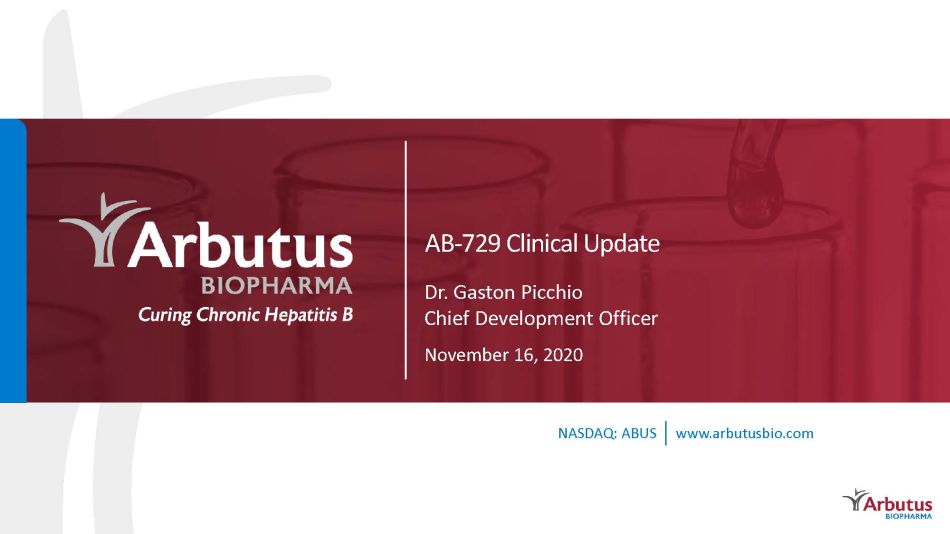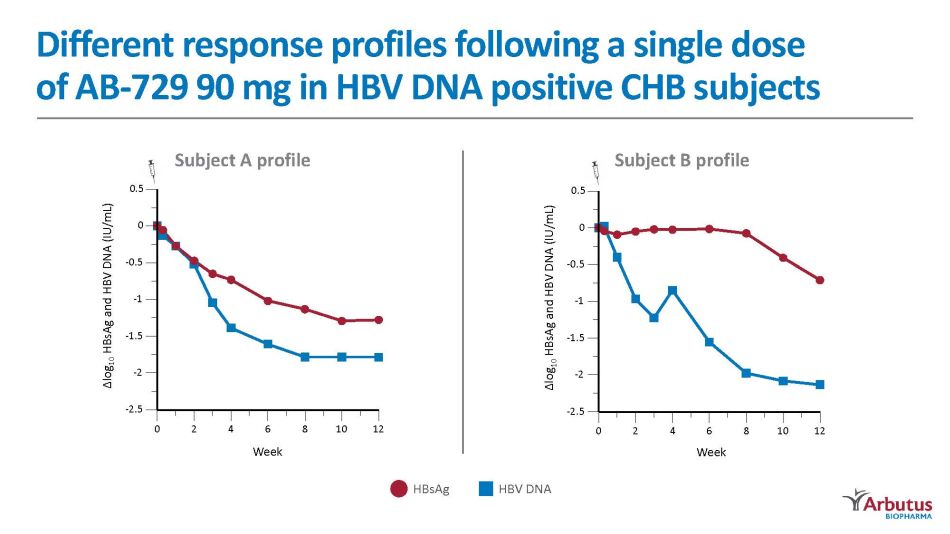Attached files
| file | filename |
|---|---|
| EX-99.2 - PRESS RELEASE - Arbutus Biopharma Corp | exh_992.htm |
| EX-99.1 - PRESS RELEASE - Arbutus Biopharma Corp | exh_991.htm |
| 8-K - FORM 8-K - Arbutus Biopharma Corp | f8k_111620.htm |
EXHIBIT 99.3

NASDAQ: ABUS www.arbutusbio.com AB - 729 Clinical Update Dr. Gaston Picchio Chief Development Officer November 16, 2020

Forward - Looking Statements This presentation contains forward - looking statements within the meaning of the U . S . Private Securities Litigation Reform Act of 1995 and Canadian securities laws . All statements that are not historical facts are hereby identified as forward - looking statements for this purpose and include, among others, statements relating to Arbutus’ expectations to conduct Phase 2 combination studies with AB - 729 dosing as infrequently as every 8 or 12 weeks ; Arbutus’ expectation that AB - 729 could be effective at dosing intervals of every 8 or even every 12 weeks ; Arbutus’ expectations that additional data results from the AB - 729 60 mg 8 week cohort will be available before the end of 2020 ; Arbutus’ expectation that AB - 729 could be the cornerstone of future combination regimens for the treatment of chronic hepatitis B infection ; and other statements relating to Arbutus’ future operations, future financial performance, future financial condition, prospects or other future events . With respect to the forward - looking statements contained in this presentation, Arbutus has made numerous assumptions regarding, among other things : the timely receipt of expected payments ; the effectiveness and timeliness of preclinical studies and clinical trials, and the usefulness of the data ; the timeliness of regulatory approvals ; the continued demand for Arbutus’ assets ; and the stability of economic and market conditions . While Arbutus considers these assumptions to be reasonable, these assumptions are inherently subject to significant business, economic, competitive, market and social uncertainties and contingencies including uncertainties and contingencies related to the ongoing COVID - 19 pandemic . Forward - looking statements herein involve known and unknown risks, uncertainties and other factors that may cause the actual results, events or developments to be materially different from any future results, events or developments expressed or implied by such forward - looking statements . Such factors include, among others : anticipated pre - clinical and clinical trials may be more costly or take longer to complete than anticipated, and may never be initiated or completed, or may not generate results that warrant future development of the tested drug candidate ; changes in Arbutus’ strategy regarding its product candidates and clinical development activities ; Arbutus may not receive the necessary regulatory approvals for the clinical development of Arbutus' products ; economic and market conditions may worsen ; and market shifts may require a change in strategic focus ; and the ongoing COVID - 19 pandemic could significantly disrupt our clinical development programs . A more complete discussion of the risks and uncertainties facing Arbutus appears in Arbutus' Annual Report on Form 10 - K, Quarterly Report on Form 10 - Q and Arbutus' periodic disclosure filings which are available at www . sec . gov and at www . sedar . com . All forward - looking statements herein are qualified in their entirety by this cautionary statement, and Arbutus disclaims any obligation to revise or update any such forward - looking statements or to publicly announce the result of any revisions to any of the forward - looking statements contained herein to reflect future results, events or developments, except as required by law .

AB - 729 - 001 Study Overview Presentation includes data available through 06 - Nov - 2020 HBV: Hepatitis B Virus | TDF: tenofovir disoproxil fumarate (≥ Day 15 Safety) Cohort A: 180 mg HBV DNA - n =4 Cohort B: 60 mg HBV DNA - n =6 Cohort C: 90 mg HBV DNA - n =6 Cohort D: 90 mg HBV DNA + n =6 Part 2: Single Doses in Chronic Hepatitis B Subjects (open - label) Part 1: Single Ascending Dose in Healthy Subjects Dose 1 (60 mg) n=6; 4 active : 2 placebo (≥ Day 15 Safety) Dose 2 (180 mg) n=6; 4 active : 2 placebo Dose 3 (360 mg) n=6; 4 active : 2 placebo (≥ Day 15 Safety) Cohort E: 60 mg Q4W HBV DNA - n =7 Part 3: Repeat Doses in Chronic Hepatitis B Subjects (open - label) Cohort I: 90 mg Q 8 W H B V DN A - n =7 Cohort J: 90 mg Q12W HBV DNA - n =7 Cohort F: 60 mg Q8W HBV DNA - n =7 Cohort G: 90 mg Q8W + TDF: HBV DNA + n = 7 upd a t e (≥ Day 15 Safety) n e w

Baseline Characteristics Baseline Measure Cohort A 180 mg (N=4) Cohort B 60 mg (N=6) Cohort C 90 mg (N=6) Cohort D HBV DNA+ 90 mg (N=5*) Cohort E 60 mg Q4W (N=7) Age in years, mean (range) 42.8 (35 - 53) 48.2 (33 - 56) 54.8 (47 - 62) 43.6 (35 - 57) 45.1 (33 - 63) Male gender, n (%) 3 (75%) 3 (50%) 6 (100%) 3 (60%) 4 (57%) BMI, mean (SD) 23.7 (3.62) 26.6 (3.23) 25.2 (1.96) 29.2 (5.42) 27.7 (5.01) Race, n (%) Asian 0 3 (50%) 6 (100%) 0 1 (14%) White 4 (100%) 3 (50%) 0 4 (80%) 6 (86%) Pacific Islander 0 0 0 1 (20%) 0 ALT (U/L), mean (SD) 39.3 (35.36) 20.0 (6.52) 25.5 (9.23) 31.6 (13.43) 22.4 (10.52) HBV eAg negative, n (%) 3 (75%) 6 (100%) 6 (100%) 5 (100) 7 (100%) HBsAg (IU/mL), mean (range) 8577 (4720 – 10289) 2095 (405 – 5110) 822 (261 – 1400) 2336 (317 – 6451) 5372 (584 – 11761) HBV DNA (IU/mL), mean (range) N/A N/A N/A 86840 (1220 – 360560) N/A *One subject experienced a spontaneous HBV flare prior to dosing and was excluded from the analysis

Mean (SE) Week 12: - 1.10 (0.15) Mean (SE) Week 16: - 1.44 (0.18) Mean (SE) Week 20 : - 1.71 (0.18) Mean (SE) Week 24 : - 1.84 (0.10) [N=3] Repeat dosing of AB - 729 60 mg every 4 weeks results in continuous mean HBsAg declines beyond Week 12 5/7 HBsAg <100 IU/mL 1/7 HBsAg <10 IU/mL AB - 729 60 mg Q4W Mean ( ц SE) HBsAg declines across Cohorts Mean Individual *N=5 at Week 10, 14, 18 and 22 **N=4 at Week 14 - 20; N=3 at Weeks 22 – 24 # N=6 at Week 6; N=3 at Week 24 SD: single dose; Q4W: every 4 weeks

AB - 729 90 mg single dose reduces HBsAg and HBV DNA in HBV DNA positive CHB subjects 2/5 HBsAg <100 IU/mL 0/5 HBsAg <10 IU/mL HBsAg (N=5) HBV DNA (N=5) Mean HBsAg decline is similar to HBV DNA negative CHB subjects Mean Individual Week 12 - 2 .5 - 2 - 1 .5 - 1 - 0 .5 0 0 .5 0 8 10 12 Week 12 - 2 .5 - 2 - 1 .5 - 1 - 0 .5 0 0 .5 0 2 4 6 8 10 12 Week 12 mean (SE): - 1.02 (0.13) Week 12 mean (SE): - 1.53 (0.24) M e an Individual ∆log 10 HBsAg (IU/mL) ∆log 10 HBV DNA (IU/mL) 2/5 HBsAg <100 IU/mL 0/5 HBsAg <10 IU/mL 2 4 6 W eek W eek

Different response profiles following a single dose of AB - 729 90 mg in HBV DNA positive CHB subjects Subject A profile Subject B profile H B s Ag HBV DNA - 2 .5 - 2 - 1 .5 - 1 - 0 .5 0 0.5 0 2 4 6 8 10 12 - 2 .5 - 2 - 1 .5 - 1 - 0 .5 0 0 .5 0 2 4 8 10 12 6 W eek ∆log 10 HBsAg and HBV DNA (IU/mL) ∆log 10 HBsAg and HBV DNA (IU/mL) W eek

AB - 729 reduces HBV RNA and HBcrAg to the limits of quantification or detection in most HBV DNA+ subjects 4/5 subjects reached <LLOQ (*) or TND (#) 2/3 subjects reached <LLOQ (*) * * * # # # Maximum reductions shown up to Week 12 in subjects with quantifiable data at baseline HBV RNA HBcrAg LLOQ = lower limit of quantitation; TND = target not detected; SD = single dose HBcrAg samples <LLOQ (3.0 log10 IU/mL) assigned a value of 2.9 log10 IU/mL HBV RNA samples <LLOQ (1.65 log10 IU/mL) or target not detected assigned a value of 1.64 log10 IU/mL

AB - 729 was safe and well tolerated after single and repeat doses Subjects, n (%) Cohort A ( 180 mg) N= 4 Subjects with any TEAE 4 (100) Subjects with related TEAEs Grade 1 Grade 2 Grade 3 Grade 4 3 (75) 1 (25) 2 (50) 0 0 Most common related TEAEs (in ≥ 2 subjects): ALT elevation# AST elevation Headache 2 (50) 1 (25) 2 (50) Injection site pain Injection site erythema Injection site bruising 0 0 0 ▪ No SAEs or discontinuations due to AEs ▪ No treatment - related Grade 3 or 4 AEs - 1 subject (Cohort A) with rapid decline in HBsAg of ~2.0 log10 IU/mL had an unrelated Gr 2 AE of food poisoning resulting in unrelated transient Grade 3 AEs of ALT/AST elevation (without bilirubin changes) ▪ No other Grade 2, 3 or 4 laboratory abnormalities ▪ Injection site TEAEs were mild (erythema, pain, pruritis, bruising) or moderate (pain) and transient ▪ No clinically meaningful changes in ECGs or vital signs *One subject experienced a spontaneous HBV flare prior to dosing and was excluded from the analysis Grading criteria based on Division of AIDS Table for Grading the Severity of Adult and Pediatric Adverse Events, Corrected Version 2.1., July, 2017 #ALT and AST elevations were all Grade 1 excepting two Grade 2 ALT in Cohort E, all were asymptomatic without bilirubin changes † 4/5 subjects from same site; 2 Gr 2 TEAEs had AB - 729 dose erroneously split into 2 injections, all TEAEs lasted <1 hour ‡ n, % is number of events out of 63 total AB - 729 doses administered

Additional data presented today further reinforces efficacy and safety of AB - 729 In Cohort E, repeat 60 mg Q4W dosing with AB - 729 resulted in a continuous and robust HBsAg decline at week 20 ( - 1.71 log10 IU/mL). Further reductions continued beyond week 20 ( - 1.84 log10 IU/mL, N=3) ▪ No plateau effect in HBsAg decline observed to date during repeat dosing In HBV DNA positive CHB subjects, a single 90 mg AB - 729 dose resulted in robust mean HBsAg ( - 1.02 log10 IU/mL) and HBV DNA ( - 1.53 log10 IU/mL) declines at week 12, as well as decreases in HBV RNA and core - related antigen ▪ Similar HBsAg reductions were observed in HBV DNA positive and negative CHB subjects ▪ These findings support complete target engagement by AB - 729 AB - 729 remains generally safe and well tolerated These results support advancing AB - 729 to Phase 2 combination studies with AB - 729 dosing as infrequently as every 8 or 12 weeks
